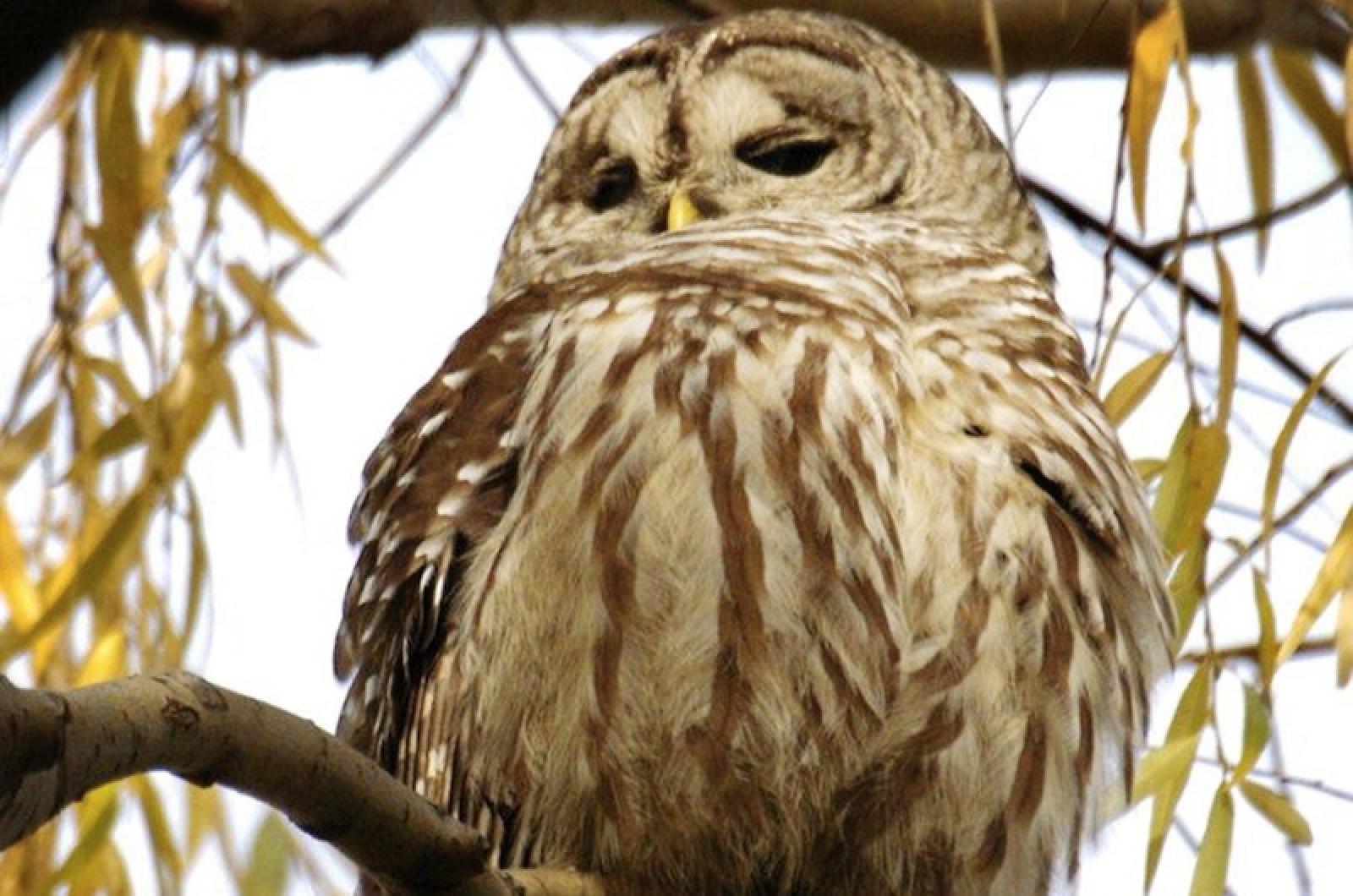A barred owl was last seen on Martha’s Vineyard on Nov. 8, 1948. That is 68 years ago. And that was only the third sighting of this species on the Island since 1918.
On April 14, Elaine Graves was reading a book to her son Connor, when they heard an owl hooting outside their closed window on North street in Edgartown. They recorded the call on a cellphone; husband Joel Graves joined them and they used the internet to identify it as a barred owl.
Barred Owl Call

However, it was not the typical “Who cooks for-you, who cooks for-you-awl” barred owl call; the cadence of the deep hoots was recognizable but the last syllable was missing.
To confirm the identification, Mr. Graves emailed the recording to me. Although I was certain of the identification, barred owls had not been seen on the Island since 1948, so I forwarded the email to a few other birders. Sarah Mayhew, Pete Gilmore and Wayne Petersen all confirmed the identification.
Data from the Federal Breeding Bird Surveys and MassAudubon’s Breeding Bird Atlases shows that this species was traditionally absent from the Cape and Islands area, but in the past 30 years or so, it is now found on much of Cape Cod, especially in Mashpee and Barnstable. So it is not totally unexpected to have one show up on Martha’s Vineyard. But what happened next was not expected.
After publicizing the sighting, Allan Keith called to say that Jim Harrison heard and saw a barred owl on April 19 in the Island Grove subdivision, less than one mile west of the initial location. And then Norma and Geoff Kontje told me they heard two barred owls calling back and forth last summer, and that Mr. Kontje had heard one again on April 21.
Four different sightings of barred owls within one week — a species that had not been found on the Island since 1948 — is totally unexpected. And discovering such range expansions are one reason why we find birding so interesting.
It is thought that the lack of mature swampy woodlands, its preferred habitat, explains its historic absence.
Bird Sightings
One eagerly anticipated spring arrival is the ruby-throated hummingbird; many have been putting out their sugar-water feeders and watching for them. The first report of a hummingbird this year is from Robert Ozycz Sr., who saw one in his Chappaquiddick yard on April 24. Ken Magnuson also observed a hummer on April 25; it was trapped in his shop at the Edgartown Golf Club but fortunately got out and returned to the wild. Penny Uhlendorf also observed a ruby-throated hummingbird in her yard on the afternoon of April 25.
The first Baltimore oriole returned on April 24, appearing at Ms. Uhlendorf’s feeder. She puts out jelly for them; oranges cut in half are another frequent method of attracting these incredibly orange birds. Maggie Bresnahan reported one at her feeder on April 25.
Nancy Weaver and Margaret Curtin found the first eastern kingbird of the year on a fence alongside North Road near Seven Gates Farm on April 24.
Also on April 24, Pam and Rob Davey went to Waskosim’s Rock and found three new species for the year: black and white warbler, ovenbird and white-eyed vireo. They also observed hermit thrush, yellow-rumped warblers and chipping sparrows. Mr. Magnuson also reports black and white warblers and a northern parula at Waskosims the same day. That day, Norma Kontje also observed a black and white warbler in her Chappaquiddick yard.
Sally and Glenna Barkan had both chipping sparrows and pine warblers at their Oak Bluffs home on April 24. The presence of both species provides a great opportunity to learn how to distinguish these very similar songs, if you can call these sometimes not very musical utterances songs.
So April 24 was a good day for finding migrants! For the next six weeks migrants will be coming fast and furious. Where you look for birds matters, as I went to the head of the Lagoon that morning — normally a great location for migrants — and found only yellow-rumped warblers. That location was very exposed to the wind howling down the Lagoon, while birds are much more likely to be active where they are protected from such wind. And there was a yellow-bellied sapsucker on a tree in my yard, low on a tree trunk about as far out of the wind as can be.
Meanwhile, Soo Whiting reports phoebes, tree swallows, barn swallows, eastern towhees, downy, hairy and red-bellied woodpeckers, dark-eyed juncos and white-throated sparrows are all visiting her feeders.
And Nelson Smith reports that a dozen brant are still hanging out in Ocean Park in Oak Bluffs.
Peak migration is coming soon, so please get out looking for birds, and be sure to report your sightings to birds@mvgazette.com.
Robert Culbert leads guided birding tours and is an ecological consultant living in Vineyard Haven.
Photos of recent bird sightings on the Vineyard.




Comments
Comment policy »